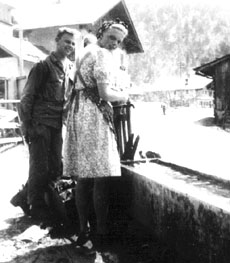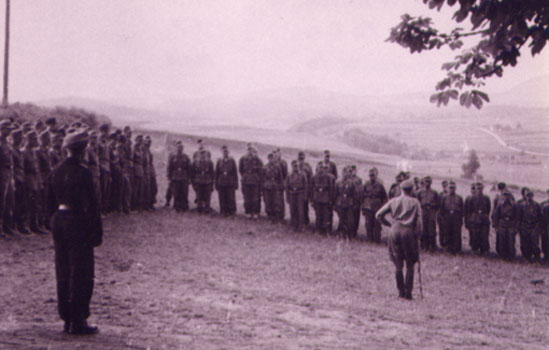
Lewis Nixon is the individual most focused-on in this episode, and we can see a maddening array of events which wreaked havoc on his psyche. The sad events connected to his liason/observer jump with the 17th ABD across the Rhine river, his pending divorce(including loss of dog), the failure to understand him by the top echelon of leaders in the 506th, his self-deprecation for not having fired his weapon in combat during the entire war, all merged, to drive his alcohol habit.
BTW, the experience of not firing a weapon in combat was not as rare as one might think. A number of men in rifle companies who DID fire their weapons, finished the war without knowing for certain if they had actually killed anybody. That was because they were usually firing at targets obscured by foliage, buildings, poor visibilty or distance/movement. Even in an elite, behind the lines outfit like the 101st Airborne, many men did finish the war with that uncertainty. Perhaps for some, it was more of a blessing than a curse. Besides, the public at large didn't know such details, and acclaimed ALL returning survivors of the eagle division as equal heroes. It seems those who did the most were also least likely to try to exploit that fact after returning to civilian life.
Back to the Nixon scene, Winters made the remark: "you're probably the only man in the 101st Airborne with 3 stars over his jump wings." The line should have stated "...ON your jump wings." Little bronze campaign-type stars were affixed to the front of parachute wings, to signify combat jumps. Most members of the 101st did finish the war with two stars affixed, one for Normandy the other for Holland. But there were probably half a dozen who were eligible for FOUR stars. One of them was Lt Schrable Williams, who made Normandy and Holland, then jumped the Pathfinder resupply jump at Bastogne (the famous brick pile incident), then made a 4th combat jump at Briealf, Germany in spring, 1945. This was again a Pathfinder jump, to signal an Airborne gasoline resupply for the 4th Armored Division. A handful of other 506th Pathfinders, including Jack Agnew, made the same jumps. Of course Winters probably didn't know about the 4-combat-jump members of the 506th in 1945, so this is not a mistake in the series, but a clarification. Some years after WW2, the Senior and Master Parachutist badges were introduced and those did feature a star or a circled star "over" (above) the canopy of the parachute. That is why the dialogue should have been written a bit more carefully.
In the scene in which Perconte berates the replacement O'Keefe, for being an overzealous rookie, there are finally bullets with projectiles visible in the machine-gun belt, (although the bullets look like they are coated with 50 years of tarnish, and no tracers are present) and there is a nice detail of a real 1940's vintage .30 caliber ammo can. The computer technology which created the hordes of surrendering Germans on the middle of the autobahn looked great, but again David Webster is mis-portrayed in shouting and cursing at them. At least Don Malarkey says he doesn't remember Webster doing that, and it seems much out of character with the Webster he knew. Of course Webster would have cursed them eloquently had he chosen to do so, but he was a writer and preferred to express his resentments toward Hitler's minions with a typewriter.
In the scene in which 3 German PWs are herded out of a building to be executed with gunshots to the head beside the road, I hope most of the viewing audience was aware that the executioners were FRENCH SOLDIERS, and NOT American GIs. There was no dialogue to point this out, and the only uniform difference obvious to most viewers, was the French steel helmets.
Dave Webster's revulsion over these unnecessary late war killings was another powerful element of his writings, which was ommitted from the film. After describing how he viewed the brains of one victim "...red and yellow and purple on the snow behind him", Webster went on to write:
The Frenchman stepped up to his last prisoner. This boy was the youngest of the three. He had never shaved. He had soft brown eyes, and a pink adolescent face that had never been creased by worry or the awareness of death. All the thoughts that old men have but that he never had crowded in an instant into his mind and came out in his eyes and on his forehead. Framed by the dark pines, he put his hands together and prayed and cried softly and waited to die. The DUKW moved forward and we heard the shot from the distance.
I turned to a cocky, bubbling young replacement who had been eager to see action. 'There's your goddam war!' I said. 'How do you like it?' He gulped and shook his head."
Again, powerful stuff, some of Webster's best, which he surely would have wanted them to use. But because they chose to use his character to portray a different agenda, his REAL writing wouldn't have fit.
I also lament the callous attitude of Generation Xers, who have become numb to the sights of death, mutilation and suffering on the screen. Do they understand that these are real events, involving real victims that they are watching, or do they fail to discern the difference from their fantasy films? After seeing movies like 'Starship Troopers', wherein human bodies are shown torn to pieces, lying everywhere, eviscerated by fictitious giant insects, can they still seperate real mass murder from science fiction? When I saw the carnage in 'Starship Troopers', I was struck by how similar some scenes were to what actually happened in la Lande des Morts in France, in July, 1944. At the same time, I realized that a screen recreation of that mass death scene would be diminished in impact when shown to an audience accustomed to seeing similar carnage in fantasy films. So I'm really wondering if Episode 9's attempt to depict the horrors of Hitler's mass death apparatus had any real impact on Generation 'X' audiences? This is no reflection on the quality of the camp depiction in this episode, just a question of whether ANYTHING can impact these modern audiences. This desensitizing of our younger generation is the legacy which contemporary Hollywood films have given us. When a true horror story comes along, much of its shock value is lost on these young viewers.
BTW, in the scene wherein Colonel Sink radios General Taylor to inform him of the discovery of the camp, he would NOT have had to say "Colonel Sink, 506th" I think Taylor knew which regiment Sink commanded by the spring of 1945.
Pee Wee Martin of G/506th commented that being at the Landsberg camp in person was much worse than portrayed on screen, and that most of the 'victims' depicted were about as skinny as he himself actually was in 1945. This was unavoidable, as the actors guild doesn't have a lot of members with the physique of a walking skeleton.
The main question I have about this episode is whether Captain Ronald Speirs' depicted passion for looting German souvenirs was accurate. Both in Ambrose's book and in the film, Speirs is shown avidly looting and mailing such items as Hitler's silver services, but David Webster's writings seem to contradict this.
Once again, consult Webster's book 'Parachute Infantry' on pages 181-182. Webster described the robbery of an aging, bike-riding German man, by two troopers armed with a Luger. Most of the onlookers disapproved and jeered the thieves, calling them "brave soldiers" and "Combat men!" Webster also wrote:
We also found out why an effort was made to develop a certain replacement named John A. Janovec in the previous episode, when he met a tragic death in the jeep/truck traffic mishap.
Viewers should be aware that some controversy arose amongst 506th survivors, over Ambrose's book, when he suggested that Easy 506th took the town of Berchtesgaden and that this was accomplished without firing a shot. The 3rd battalion of the 506th came into Berchtesgaden on a different route of approach, and they came under fire from the right flank by two German 88mm artillery crews. As a result of this enemy fire, they lost Nick Kozovsky (HQ Co.3rd Bn), and Claude Rankin (Co.H) both KIA, and William C. Knox of Co. I, wounded. Members of Co. H attacked and chased the German crews away. So, certain 'H' Co. officers have voiced outrage over the implication that Easy took Berchtesgaden and even more at the implication that this was accomplished without loss. Also, don't forget that a battalion from the U.S. 3rd Infantry Division was in Berchtesgaden and the Berghof complex for about four days before the next Allied troops came on the scene. They were followed by the French 2nd Armored Division, then 1st Battalion of the 506th, led by Company 'C'. The French were the first Allied troops into the Eagle's Nest at the top of Kehlstein mountain, followed by C/506th, and members of the 321st GFA battalion. There was no need for the late-arriving Easy Co. to enter the Kehlstein house with weapons at the ready; it had been secured two days before, by another battalion.

The ending of this episode, telling what happened to some of the main characters after WW2, against the backdrop of a baseball game in the beautiful Austrian alps, was very well-done and moving. As I watched this episode with Don Burgett, he pointed-out that by the time VJ Day was announced, the 506th had departed scenic Austria, and were actually stationed in dreary Joigny, France. The scene, as filmed, looked a lot better, so we can understand why it was done the way it was. But the announcement of Japan's surrender was made in Joigny.
My last comment of a critical nature concerns the "We Stand Alone Together" program, which aired a week after the series ended. I still think the actual vets should have been shown with an insert of the actor who portrayed each of them. That would have gone a long way toward enhancing viewer understanding of which character was portraying whom.
I want to thank the visitors who considered it worth their while to take the time and effort to read my comments. I know I have missed many details, but I wanted to bring-up the ones that were important to me. I invite all of you who have a different list of their own, to post their comments on my forum discussion board. Also, thanks again to screenwriters John Orloff and Bruce McKenna, for taking the time to read this, and to post their comments on the Forum. Many thanks and best regards to all,
Mark Bando, Webmaster of Trigger Time.